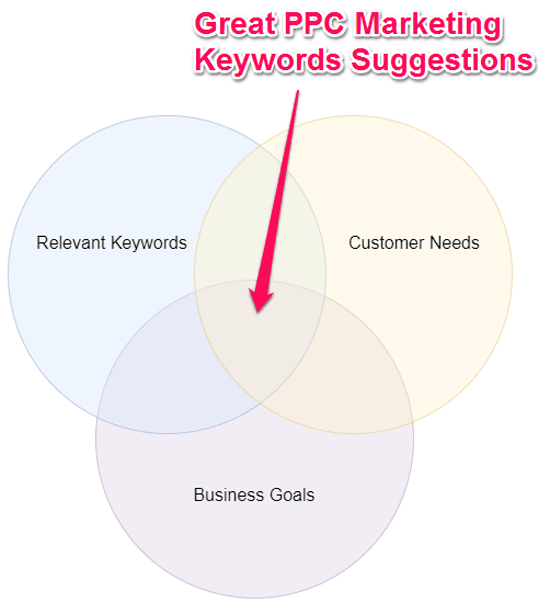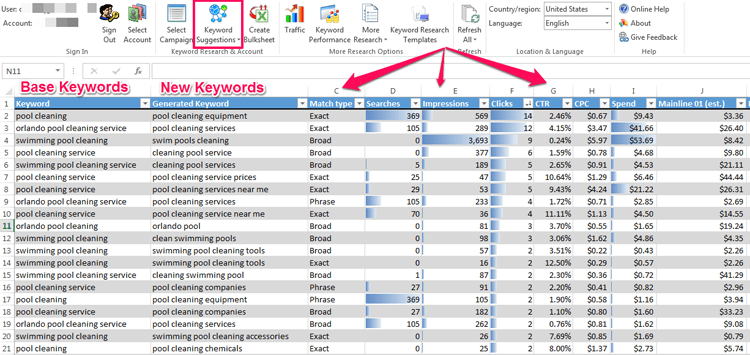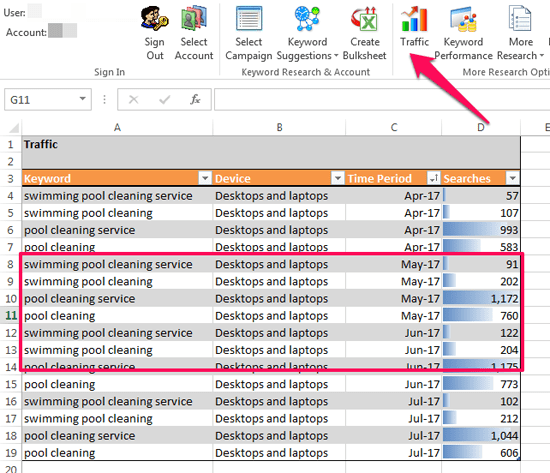Which marketing metrics should your business monitor for higher ROI? Top marketing experts share all in this roundup post.
We’re living in a data-driven world, and numbers are everything. Your results won’t matter if you can’t prove them.
And you won’t be able to grow your business if you aren’t consistently tracking and working on the most important indicators.
However, a common mistake online business owners and even plenty of digital marketers make is spending too much time and energy on metrics that don’t bring results.
We like to call these vanity metrics.

You might be familiar with some of them and maybe have even fallen into that trap yourself.
Things such as YouTube views, Facebook likes, and Instagram follower counts are all metrics that brands care about these days.
What’s more, they obsess over it and invest more resources and effort into growing these, while leaving the rest behind.
Unfortunately, these can boost your ego and make your competitors jealous, but they won’t help your audience more, won’t take your business to the next level, and won’t increase conversions.
What companies should really be concentrating on are metrics such as user engagement, number of comments and shares on social media, time on page, number of opt-ins, etc.
These are the KPIs that count, that bring value, growth, and exposure.
But you don’t need to take our word for it.
Because we all need to revisit our metrics periodically and align them with our new goals and strategies, as well as current trends and tools, we gathered and asked experts in the field of Digital Marketing to share their best tips.
In this roundup post, you’ll learn about the top marketing metrics experts are using and monitoring consistently that have the best ROI, and which you can use as indicators for your business in 2018.

Andy Crestodina
Chief Marketing Officer, Orbit Media Studios
Click-through rate is going to be my obsession in 2018.
I'm making it my focus because it is the one metric common to all content marketing channels: search, social, and email.
It's also the one number that unites all marketers.
Without it, you'll fail at anything you do.
When it comes to click-through rates, the headline is the biggest factor.
Headlines take different forms in different places.
In search, it's the title tag.
In email, it's the subject line.
In social media, it's the post itself.
In the ongoing war for attention, we need to be more focused than ever on these aspects in any piece of content.
It's a key part of every past and future success and failure.
As a reminder of the importance of a headline, remember this: no one ever shares an article, they only share the headline.
All the advice we've read over the years is good. But in the future, we should use these tactics in combination, instead of using and relying on just one.
- Add numbers.
- Ask a question.
- Use unexpected words.
- Trigger emotion or curiosity.
- Indicate a strong, specific benefit.
Also, tailor the headline for the purpose and the channel.
The title (search) doesn't have to be the same as the headline (social) or the subject line (email).
Remember that headlines that answer questions do well in search.
Headlines that trigger emotion do well in social and email.
Adapt your headlines for their placement and intended purpose!
---

Luke Fitzgerald
Head of SEO, Wolfgang Digital
Search visibility is our primary SEO reporting KPI moving into 2018.
Rather than focussing on the fluctuation of individually tracked keywords in a given location, the key to achieving better organic search results for our clients is in cumulatively moving the dial across a tiered and prioritized set of keywords, which we know will impact conversion.
Of course, visibility is borne of non-branded rank-tracking projects and will be shaped and defined by converting organic traffic metrics.
Our SEO tool metrics will go hand-in-hand with Google Analytics data for reporting purposes.
Competitive search visibility indexes across our tracked keyword sets in Moz, SEMRush, and Sistrix will be the dial for campaign success measurement.
We expect to see the role of voice search rise in prominence in the year ahead, resulting in a need to track some longer-tail queries and devise a course of action for optimising them.
Presently, that involves devising featured snippet strategies for our clients, based on the assumption that they'll remain the primary data source for voice assistants and mobiles to read aloud from the SERPs.
That may well change in 2018 as Google and other search engines up their game around voice search insights—perhaps we'll see a dedicated section in Search Console for them.
We'll be on hand to react and adapt to any changes in this regard.
Search visibility versus your main competitors is a vital metric to prioritize because it's really the only level playing field we have left to keep track of!
For example, should Google decide to move the goalposts at any time and say, introduce a 6th ad atop the SERPs or take over the entire first page, then there's not much that we, as SEOs can do about that!
The beauty of tracking visibility versus competitors as a reliable benchmark of success is that if that does indeed happen, then it affects the competition too and not just your site, making it a truly beneficial metric to track and measure as your website evolves within the ever-changing competitive SERP landscape.
My advice to any aspiring marketers looking to learn more about the search visibility metric is to check out what the various SEO tool providers have to say about it and consider adding it to your reporting arsenal sooner rather than later!
---

Cara Hogan
Content Strategist, Zaius
This year, I'm really focused on increasing referral traffic to our website.
It's a simple metric, but will help us measure a huge shift in our marketing strategy.
I have aggressive goals around guest blogging, PR, partner marketing, and influencer marketing.
All of these programs are focused on expanding awareness of the Zaius brand and reaching new and relevant audiences with our content.
All of these programs that drive referral traffic are not easy to execute.
Each takes time, effort, and a lot of writing to pull off.
But if done well, they can greatly impact the traffic reaching your site and get in front of a lot of new people who could become customers in the future.
Write up an actionable plan for everything, including a target number of guest blog posts, a target audience for influencers, and a focused strategy for partner marketing. Then, stick to it!
---

Ben Carpel
CEO, Cyfe
This year, I'm paying extra attention to metrics relating to my website's product feature description pages.
—that is, what percentage of new users viewed these pages before converting, which pages draw the most views and longest sessions, and what keywords referred search users to these pages and resulted in them converting.
As part of our recent website relaunch, we published several product feature pages that didn't exist in our earlier design.
We hypothesized that publishing these pages would be the key to attracting high-intent visits.
Tracking the impact of this strategy and optimizing its execution over the next few months is important to us.
The strategy ought to be a big success, on a theoretical level.
We just need to ensure these pages are as impressive as they can be, so they can become top-performing touchpoints in our customers' journeys.
I recommend that marketers turn their product feature description pages into valuable resources to provide readers with useful information—even if these readers never use your product.
If the information is helpful and is presented in a way that has broad appeal, it will naturally draw social shares and backlinks.
Over time, more people will discover your products thanks to this content and will eventually convert after having landed on your site.
---

Guillaume Decugis
Co-Founder & CEO, Scoop.it
This year, our focus is on two things. Firstly, web share of voice, which is the number of times our brand is mentioned in web content vs. our competitors' brands.
And secondly, content performance vs. competitors, which involves shares over social networks that our content generates in comparison to our competitors.
Several dynamics make us want to focus on this.
- We've historically been very focused on what happened with our own website and content as this is more directly within our control.
- But as we built relationships with more and more influencers, we also saw a need to measure more broadly the impact of our influencer marketing—hence the need to measure share of voice on web content.
- Content marketing is maturing and is becoming more competitive; it's content shock, as Mark Schaefer would say. As more and more marketers embrace this strategy, more content competes for limited attention. We want our content to stay relevant and perform in the top tier, hence the need to create benchmarks against competitors or industry references.
- We didn't have a way to really measure these metrics, but now we do. We've just launched a content intelligence platform, Hawkeye, that provides these metrics among other things.
To optimize your marketing strategies, research content before creating it.
Following your inspiration is good, but it's not enough.
To make your content stand out, research your topic, benchmark competitive content, and identify influencers.
This will help you come out with the best possible piece.
If your time researching a new piece of content is less than half the time you spend creating it, you're doing it wrong.
If influencer marketing is or will be an important part of your strategy, start building relationships as early as possible.
Learn to give before you get. Start curating and sharing the content of others without asking anything in return.
You'll learn what their content is about, which will enable you to better understand how to approach them.
You'll also get in their radar, and they'll be much more receptive when you ask them to share your content.
---

Natalie Lesyk
Digital Marketing Manager, Ning
Content monetization and community engagement are my focus in the year ahead.
Not only is content monetization one of the top trends in 2018, the internet is flooded with low-quality content.
Shifting the paradigm to the creation of deeply researched articles increases the ability to monetize your website or blog and guarantees that your content will stand out.
For sure you can create ebook and sell it on Amazon, but don't you agree that buying an ebook is not an impulse purchase?
Purchasing decisions can be difficult. High-quality content influences purchases.
With that in mind, article monetization is like shelling peas.
To effectively implement this strategy, build a community—your followers are the engine of your blog.
The more your followers like what you are writing, the higher profits will be.
So don't stay mediocre; take a helicopter view of what you have written and ask yourself sincerely, "If I stumbled upon this article, would I skip it or take every bite of it?"
Launch a paid access feature on your blog to monetize posts or articles.
NING could be a good fit for this. And don't forget to add a donate button.
If you are pursuing non-profit goals, it's a must. This button can be useful in many other cases too.
There are always grateful readers who will be happy to express their appreciation.
---

Chris Nolan
Conversion Optimization and Growth Manager, BigCommerce
In 2018, we see a lot of opportunity in "soft-offer" lead capture.
We frequently see prospects requesting a product demo or starting a free trial for lack of a better choice, but they aren't really ready to experiment with the product.
By prompting those users with a soft offer—such as a content download, webinar invitation, or newsletter subscription—we give ourselves a better chance to nurture the lead to a point where they are more qualified and educated to take action within the product.
As marketers, it's important that we grow trial and demo numbers, but the most significant metric is what percentage converts to paid customers.
We've seen good success with softer offers in 2017 with respect to ultimate paid conversion, so we'll continue to invest in providing prospects for these 'micro' conversion opportunities in 2018.
It’s important that marketers know how to test and track. With the volume of content we are constantly producing, we luckily have a lot of options in terms of what we promote at any given time, and to which audience.
Understanding what works—and inevitably, what doesn't—comes down to identifying which cohorts you are targeting, testing different content, and content presentation (e.g., CTA, placement on the page, messaging, thank you page execution, etc.), and then relaying those insights back into similar campaigns or initiatives.
Also, marketers shouldn't be afraid to track at a very granular level. Do the changes you're making affect bounce rate, time on page, pages/session, and so on?
Are prospects engaging with your CTAs, but not ultimately converting (and if so, could it be the form)?
How does your change affect scroll depth? For every test, you should take time to define the right KPIs so you can answer questions about their effectiveness.
---
 John Rampton
John Rampton
CEO and Founder, Calendar.com
How many people opt in and how many shares will be my focus in 2018.
It's not about how many come to the website and visit.
It's about how many engage and feel compelled to share.
Audience engagement tells me that the content is relevant and valuable.
It also says we have a product and solution the audience is seeking.
The focus on results and conversions are integral to this change, rather than just traffic volume.
It's critical to create the best content possible because that will garner shares and get people to sign up for your newsfeed, blog, and email information.
That means planning out all that you want to share with your audience and also getting them to tell you what they are specifically looking for, so you can craft content around those needs and interests.
---

Alexandra Tachalova
Founder of Digital Olympus, Digital Olympus
I want to learn more about how users interact with content.
I want to work with Google Tag Manager triggers to see whether it's possible to improve the bounce rate by changing the site's structure, by adding interactive content and videos, and by improving navigation and design.
Nowadays, user behavior is a very influential metric that contributes to a site's Google ranking.
I believe it is crucial to make the most of what you have.
This is especially true when talking about pages that have the potential to rank well with Google but have statistics that show users don't want to stay on them for very long before proceeding to other pages.
Using Google Tag Manager more often can achieve this.
Similar tools to try include Hotjar, which allows you to see how exactly users are interacting with a website.
---

Aaron Orendorff
Editor in Chief, Shopify Plus
My priorities for 2018 are first, time on page, and second, in-PDF link clicks.
Far from a vanity metric, time on page can tell you not only how engaging your content is, but also what posts resonate the most with your audience.
Instead of waiting for SEO to kick in, time on page can quickly indicate what articles to promote and prioritize for lead generation.
By creating UTMs within gated assets—like PDFs—you get a secret window into a lead's readiness to buy and what topics to lean on, bring up in sales calls, and create additional content around.
To achieve this, I recommend that marketers create a custom Google Analytics dashboard just for time on page (and force yourself to ignore traffic).
For the in-PDF links, either use a UTM builder or—even better—link those links to your CRM (like Hubspot or Salesforce).
---

Slavcho Panov
SEO expert, Seoslav
The factors I am going to focus on in 2018 are user experience and time spent on the site
The factors I am going to focus on in 2018 are user experience and time spent on the site because most people are struggling to gain organic traffic by ranking for different terms.
I am going to analyze these metrics by using the inbuilt features in Google Analytics and some paid Heatmap tools for A-B testing.
The most important thing after a user has landed on our website is to keep them there.
Of course, we should provide relevant information, products, or services they are interested in.
Once we have the user on our site, we have to analyze the overall user's experience to conclude why he or she has left the page or has continued browsing.
We should treat every single visit to our site(s) as a unique opportunity.
If we can attract the user's attention to visit our site, we should be prepared to keep them there by providing something exclusive.
Furthermore, give them something even better than what they searched for. That way we will get a faithful reader or a loyal client.
To implement this strategy, follow these steps.
- Install a heatmap on your website. This will help you visualize the user's experience.
- Keep track of your bounce rate's percentage. Combined with the heatmap, this will indicate why users stay or leave.
- Analyze the collected data from your heatmap tool.
- Make some minor changes to your site's structure, navigation, or design for A-B testing. Track down the result after every change you make.
- Rinse and repeat.
---

Zac Johnson
Founder, Blogging.org
In 2018, I would like to focus more effort on seeing what websites, blogs, and opportunities actually provide the most ROI based on the time and effort it takes to acquire such postings.
I've always been a big believer in content creation and guest blogging on other sites.
In 2018, I would like to focus more effort on seeing what websites, blogs, and opportunities actually provide the most ROI based on the time and effort it takes to acquire such postings.
Knowing which websites or blogs actually provide the most views, clicks, and engagement would be a huge benefactor, as it would allow me to know where to spend my time and effort wisely.
Contributing quality content definitely takes up a lot of time and resources, so eliminating any lower quality sites from the mix would definitely improve ROI across the board.
Today’s marketers need to focus on quality over quantity.
No matter what you are working on (content creation or SEO), always go for the higher quality method and try not to cut corners.
This will not only help in the long run, but it will also keep you on good terms with Google.
---

Benji Hyam
Co-Founder, Grow and Convert
In the coming year, we're going to be emphasizing first-click attribution for ourselves and across all of our clients.
First-click attribution helps us understand how a prospect originally found out about us.
It's unlikely that a prospect converts on your site in the same session, and because most companies only measure last-click attribution, they don't have clear visibility into what channels are influencing a sale.
Most prospects don't convert the first time they've heard about your company.
Typically, they'll find out about you from a Facebook ad, a blog article, SEO, or some other channel.
Then, they'll do some research on your site to figure out what you're about and they may interact with you multiple times before ever converting.
If you measure last click attribution only, you're unlikely to see the point of origination where your prospect found out about you.
Thus, when you're making the argument to your executive team about where to focus budgets, you likely don't have the data necessary to argue that you should focus on certain channels.
First-click attribution gives you a more holistic picture of what's working in marketing.
Dig into Google Analytics’s new attribution feature to get started with first-click attribution.
You need to have your goals properly set up in Google, but if you do, check the first interaction analysis report in Google to see how first-clicks are influencing your conversions.
---

Venkatesh C.R.
Managing Director and CEO, Dot Com Infoway
GAP analysis is one factor marketers and business owners should consider in the year ahead.
With the substantial amount of data available within the Google Analytics and Google Webmaster Tool dashboard, one can easily evaluate the current traffic the website drives against the potential traffic the website could attract from search engines.
For SEO campaigns shifting the focus to content-driven strategy, GAP analysis is a must as it is the most effective analysis segment to ensure campaigns give the expected result.
Additionally, from GWT you can create a report that shows queries and landing page combinations that receive a high number of impressions but have a low CTR.
You can also pull in each page’s current title tag, meta description, and character counts, so you can quickly analyze which search snippets can be improved to boost your CTR.
Heat map analysis helps you spy on your visitors and make arrangements within your website or page to change your visitors into customers.
In a nutshell, you can use this for various purposes. A couple of my favorite elements are:
- Improving internal links
- Optimizing call to action and image placements
When heat maps are evaluated properly, this will be a pathway to increased conversions.
When it comes to GAP analysis, keyword ranking alone does not determine SEO success.
Even when a page ranks well for a website, the CTR determines the success of the efforts that helped bring the page to the top.
Users typically select a site in less than five seconds and click the first promising link they see.
Improving CTR using GAP analysis should be an ideal metric for success.
Additionally, when one spends a substantial amount of time and money in generating quality content, the GAP analysis is a must to reap the full benefits.
Heat map analysis gives us a hard reality check within our website.
Users scan the website before they make quick decisions.
If they're forced to scroll down pages full of content to find what they're looking for, they usually choose to go back to Google and look for information elsewhere.
Do not hesitate to spy on competitors to fix your GAP in content elements.
Tools like SEMRush have features like "Content GAP Analysis,” which is easy to use and collects sufficient data to optimize your content.
In heat map analysis, use short sentences. Pay attention to image placements and quick loading images.
Avoid lengthy scrolls. And remember to KISS—Keep It Short and Sweet.
---

Srish Agrawal
Founder, Logo Design Team
Facebook remarketing is something we have been playing around with for a while now, but also something we can get much better at.
We will be tracking the many different ways to use Facebook remarketing, and also the individual post and sales pages being used.
We will be creating unique landing pages for these campaigns as well.
Remarketing is great for getting ads in front of visitors who may have left and didn't take action the first time around, but if you aren't split testing different options, who's to say visitors aren't going to just leave again anyway?
Look at as many different advertising options as you can for remarketing to your audience and getting them to come back to your site again.
Facebook Ads is a great option, but there are many other platforms and third party advertising solutions as well.
---

Christopher Weaver
Director of Strategy, MWI
In 2018, my focus will be on revenue from Apple/iOS 11 and micro-conversions.
Intelligent Tracking Prevention is one of the major recent changes to the industry.
Due to its effects, the gathering of data regarding consumer web use is highly time sensitive.
Likewise, improvements to attribution tracking have started to confirm what we already know: a lot of things go into a purchase before it's made.
Now we can show this decision-making process easier through Google Analytics.
My advice to other marketers who find themselves in a similar situation is to tie Google Analytics to Adwords or add third party code to ensure you’ve covered your bases – and don’t forget to update your attribution in your Analytics tool beyond just last click attribution.
---
Conclusion
These big names in the marketing industry are constantly revisiting their goals, updating their approach, giving new tools a try, and staying up to date with the latest trends.
As a result, they are now focusing on metrics such as brand mentions instead of just likes or follows.
It’s more important to know how many people share and comment on your content and updates than to just wait for new visitors to come to your website, thinking you’re doing it right.
Engagement shows that your content and products are relevant and provide value and that this is what you need to do more of to improve or even double your results.
In 2018, make sure you track the interaction between a prospect and all your platforms and online presence.
Hearing about you somewhere else, going to your website, and clicking a link isn’t enough anymore.
The relationship is built after a few more actions.
You only have someone’s trust and attention when they sign up for your newsletter, connect with you personally, download a file to learn more about your offer, and engage with your content instead of just skimming an article or liking a video.
With the beginning of the new year, take the initiative to rethink your marketing metrics and make sure they are relevant.
It’s okay to stop tracking many things and replace these indicators with new ones.
Innovation is a constant process.
After all, we’re here to serve people online, and that includes continuously adapting to user behavior and technology trends.
Georgi Todorov is a digital marketer. He recently started his own blog about digital marketing DigitalNovas . His passion is to help beginners to start and grow a successful online business. Hit him up on Linkedin or Twitter @GeorgiTodorovBG anytime.
The post 16 Marketing Experts Share the Metrics They're Emphasizing in 2018 appeared first on NinjaOutreach.
source
https://ninjaoutreach.com/marketing-metrics/

























